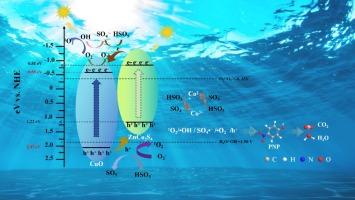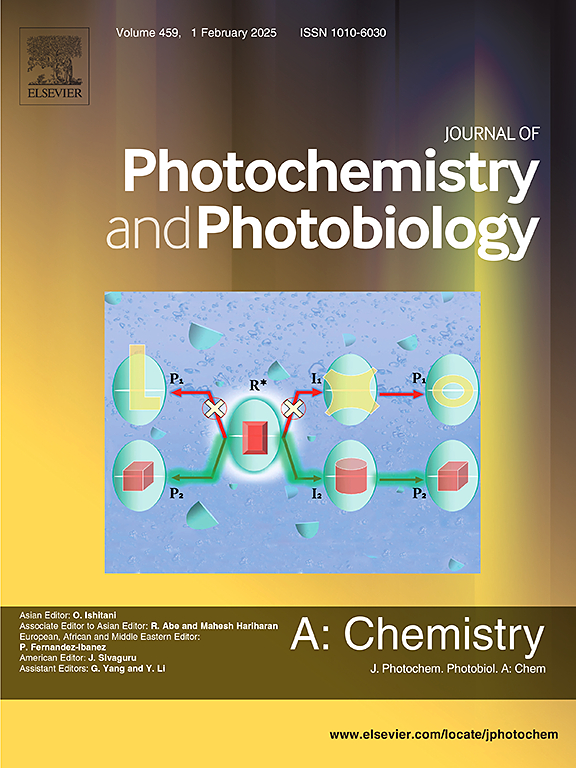ZnCo2S4/CuO heterojunction photocatalyst for activation of persulfate to degrade p-nitrophenol
IF 4.1
3区 化学
Q2 CHEMISTRY, PHYSICAL
Journal of Photochemistry and Photobiology A-chemistry
Pub Date : 2024-11-15
DOI:10.1016/j.jphotochem.2024.116146
引用次数: 0
Abstract
The degradation of para-nitrophenol (PNP) pollutant under visible light (ZnCo2S4/CuO/PMS/Vis) via ZnCo2S4/CuO heterojunction activated peroxymonosulfate has been investigated in detail. The results indicate that 50 % ZnCo2S4/CuO performs best under light conditions, and after adding 4 mM PMS, the degradation rate of PNP reaches 98 %. The study systematically examines the effects of important parameters (PMS dosage, pH, and coexisting anions) on PNP degradation and verifies the excellent performance of the photocatalysis-activated PMS system through comparative experiments. Electron paramagnetic resonance (ESR) and free radical quenching experiments revealed that 1O2 contributes the most to the degradation performance of PNP.

活化过硫酸盐以降解对硝基苯酚的 ZnCo2S4/CuO 异质结光催化剂
研究人员详细探讨了在可见光(ZnCo2S4/CuO/PMS/Vis)条件下,ZnCo2S4/CuO 异质结活化过氧单硫酸盐降解对硝基苯酚(PNP)污染物的情况。结果表明,在光照条件下,50% ZnCo2S4/CuO 的性能最佳,加入 4 mM PMS 后,PNP 的降解率达到 98%。该研究系统地考察了重要参数(PMS 用量、pH 值和共存阴离子)对 PNP 降解的影响,并通过对比实验验证了光催化活化 PMS 系统的优异性能。电子顺磁共振(ESR)和自由基淬灭实验表明,1O2 对 PNP 的降解性能贡献最大。
本文章由计算机程序翻译,如有差异,请以英文原文为准。
求助全文
约1分钟内获得全文
求助全文
来源期刊
CiteScore
7.90
自引率
7.00%
发文量
580
审稿时长
48 days
期刊介绍:
JPPA publishes the results of fundamental studies on all aspects of chemical phenomena induced by interactions between light and molecules/matter of all kinds.
All systems capable of being described at the molecular or integrated multimolecular level are appropriate for the journal. This includes all molecular chemical species as well as biomolecular, supramolecular, polymer and other macromolecular systems, as well as solid state photochemistry. In addition, the journal publishes studies of semiconductor and other photoactive organic and inorganic materials, photocatalysis (organic, inorganic, supramolecular and superconductor).
The scope includes condensed and gas phase photochemistry, as well as synchrotron radiation chemistry. A broad range of processes and techniques in photochemistry are covered such as light induced energy, electron and proton transfer; nonlinear photochemical behavior; mechanistic investigation of photochemical reactions and identification of the products of photochemical reactions; quantum yield determinations and measurements of rate constants for primary and secondary photochemical processes; steady-state and time-resolved emission, ultrafast spectroscopic methods, single molecule spectroscopy, time resolved X-ray diffraction, luminescence microscopy, and scattering spectroscopy applied to photochemistry. Papers in emerging and applied areas such as luminescent sensors, electroluminescence, solar energy conversion, atmospheric photochemistry, environmental remediation, and related photocatalytic chemistry are also welcome.

 求助内容:
求助内容: 应助结果提醒方式:
应助结果提醒方式:


